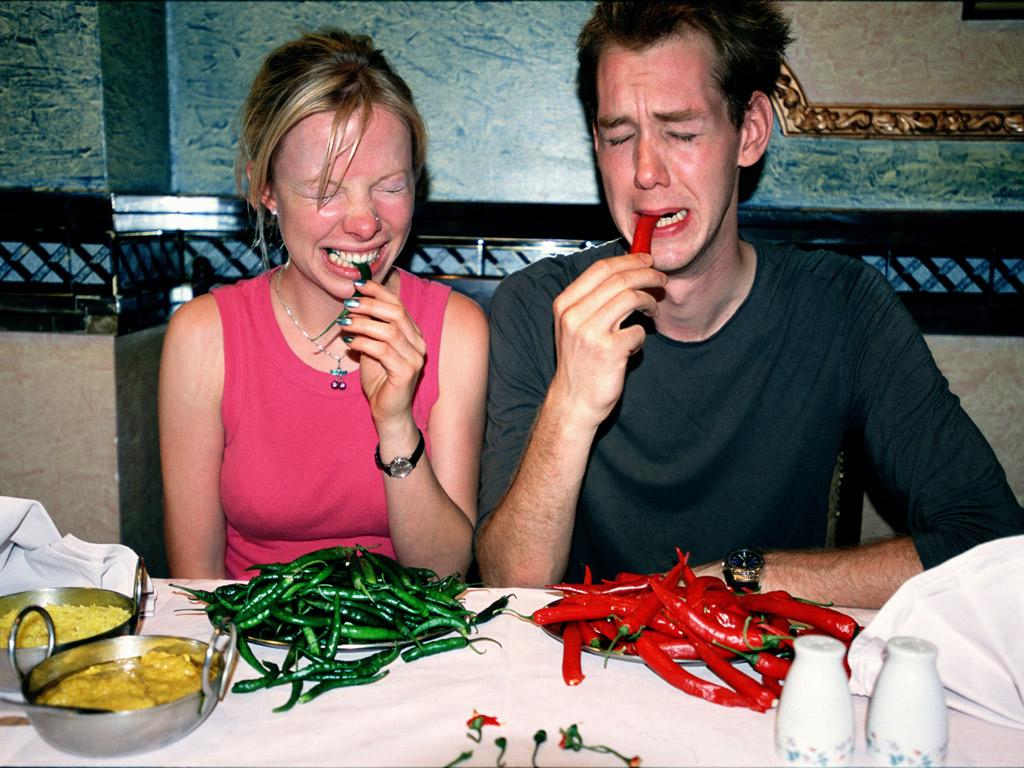Some like it hot
Britain's got the taste for spice – sales of hot sauce are on the rise and so are the scorch levels. Will Tim Walker be able to handle a 'Dragon Slayer'?

It's lunchtime at Nando's, somewhere in west London. I'm supposed to be writing about hot sauce, and since there are more than 250 branches of this South African restaurant chain in the UK, serving Portuguese/Mozambican marinated chicken smothered in hot peri peri dressing of varying strengths, it seemed like a good place to begin. I've chickened out – if you'll pardon the pun – and ordered my breast wrap in "hot", not "extra hot".
It's hottish, but I suppose I ought to sweat a bit more to fulfil my brief. There's a row of bottles on each table, containing sauces of ever-increasing heat. And at the end of the row is a small black receptacle: "Nando's X: extra extra hot," the label says, with a warning: "Devilishly fiery and highly combustible. Strictly for masochists, the unhinged and those with reckless bravado." I am none of the above, but I have a job to do. Reluctantly, I shake some of the stuff on to my wrap as if it's salad dressing, and take a bite.
In 2010, sales of hot sauces went up by 20 per cent. Today's British diners are eating food 400 times hotter than our parents could handle. And we eat more of it than anyone else in Europe. UK chilli enthusiasts have even bred two of the world's hottest natural chilli sauces: Naga Viper, of Cumbria, and Infinity Chilli, which comes from Grantham, like Mrs Thatcher. It's not just us: a recent report named hot-sauce production the eighth-fastest-growing industry in the US, just ahead of sustainable-building construction.
A colleague's husband is a collector, with a hot-sauce rack containing 20 varieties, including Dave's Insanity Sauce; Cholula Chili Lime Sauce; Sinful Sauces "Wicked" Hot Sauce; Louisiana's Pure Crystal Hot Sauce; Peprico Red Pepper Sauce; Sambal Oelek Hot Sauce; Encona Sweet Chilli Sauce; and Susie's Calypso Hot Sauce. Brick Lane's Rib Man barbecue stall in east London sells two super-hot sauces to order, called, onomatopoeically, "Holy Fuck" and "Christ on a Bike". It is possible to obtain, from somewhere in the belly of the internet, sauces such as "Colon Blow", "Dragon Slayer" and "Satan's Shit". Made with extract of capsaicin, the irritant alkaloid that makes chillies hot, some of them are stronger than pepper spray. Why are people doing this to themselves?
"If you went into Sainsbury's 15 years ago," the food writer Tom Parker Bowles says, "you'd be lucky to find one rather boring, wan bag of finger chillies from Holland. Now you'll find six or seven different kinds in any supermarket. Hot sauce is as common a condiment now as brown sauce. The super-hot sauces are all about being macho: 'My sauce is hotter than yours.' But at the quality end of the market, tabasco, for example, is one of the great sauces of all time. It adds life and flavour. I eat chilli in some form five or six times a week. And it's addictive: the capsaicin releases endorphins that fight the pain, so you get a thrill out of hot food."
Hot sauce was first bottled and sold in the US during the early 19th-century, and in 1859, a Louisiana entrepreneur named Colonel Maunsel White started growing "tabasco" peppers, and bottling the sauce for sale. In the 1860s, his friend Edmund McIlhenny obtained a patent on the tabasco hot pepper sauce that we know today. In 1912, William Scoville developed a test to determine the heat of a chilli, based on how much water one needed to dilute its effects. The world's hottest pepper is the Naga (Bhut) Jolokia, or "ghost pepper", measuring 1,041,427 on the Scoville scale.
It's 100 times hotter than a jalapeño, 200 times hotter than tabasco. The Indian army plans to use its seeds to make smoke grenades, for deployment during riots. Blair's 3am Special Reserve Sauce ($49.95, for 3 fl oz) clocks in at two million Scovilles.
Thomasina Miers, owner of Mexican restaurant chain Wahaca, has developed a range of Wahaca-branded hot sauces for supermarkets. But, she says, "I think those sauces designed to blast your taste buds into smithereens are a total waste of space. I love eating hot stuff, but chillies and hot sauces are about flavour. I actually argued with my partner over how hot our hottest sauce should be – and I argued for the flavour to hit your tongue before the heat."
Miers's latest cookbook contains a recipe for hot sauce. "Hot sauces are a good fit for us. On any cantina table in Mexico, there'll be a couple of hot sauces. In Britain we've always had mustard or mayo; we like to anoint our food with something."
Hot sauce has come here from a number of different cuisines, bearing a variety of chillies: Mexico, with jalapeños and chipotles, American cayenne and tabasco; the Caribbean's habanero and Scotch bonnet; peri peri from South Africa.
"We already had curries in our taste DNA from the Empire", Parker Bowles says. "Then came the explosion in popularity of the two great chilli cultures: Thai and Mexican."
Back in Nando's, I'm waiting for the "extra extra hot" sauce to take hold. But it's not making my eyes water. I dip a bit of wrap in a big dollop of the stuff and slide it, sauce down, straight on to my taste buds. My tongue gets hot, my mouth, too.
But I have a sip of my drink to take the edge off and... nothing much. I don't even need to take my jumper off. Somebody get me some Colon Blow.
Subscribe to Independent Premium to bookmark this article
Want to bookmark your favourite articles and stories to read or reference later? Start your Independent Premium subscription today.

Join our commenting forum
Join thought-provoking conversations, follow other Independent readers and see their replies